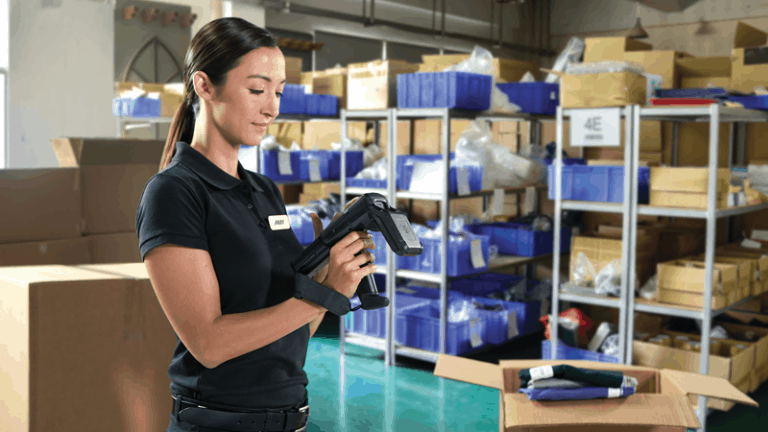Customer expectations are changing rapidly. Companies feel more and more compelled to deliver products and services in real-time because that’s part of the on-demand economy. Zebra Technologies (hereafter Zebra) sees this as a crucial development, where a technology strategy can be distinctive. We spoke with Zebra’s CTO, Tom Bianculli.
Zebra aims to support frontline workers in retail, transportation and logistics, manufacturing and healthcare. It supplies sensors, scanners and mobile computers, among other things, to those industries. If you zoom in on retail, for example, you’ll see that many supermarkets use self-scanners from Zebra. You can also think of smartphones with a clear business focus. For example, Techzine recently reviewed the Zebra EC50 and EC55, which stand out as rugged enterprise mobile computing devices with a built-in barcode reader function.
Instant experience is key
However, the diversity of Zebra’s product portfolio does not take away from the fact that customers have specific business challenges to solve. Zebra’s products, therefore, aim to achieve enterprise asset intelligence, explains Bianculli. An enterprise asset, in this case, can be a valuable or useful item, product, part, person, service or quality. Every asset is ideally visible and connected. This way, the asset can be used optimally. By providing connectivity and visibility of assets across a customer’s domain, there is the opportunity to use the collective data to gain insight into the device, the workflow and the task. Something crucial to delivering real-time experiences to the customer, Bianculli observes.
“You can no longer have a business operation where you plan for days or weeks and then execute the plan without adjustments. If you have to deliver a product within two hours, even a half-day plan is useless,” Bianculli says of the need to execute and deliver everything immediately. According to the CTO, planning and execution, today happen almost simultaneously because of customer requirements.
That’s why Zebra sees gathering data in real-time as a crucial point, to give companies visibility into what’s happening. Bianculli cites knowing where employees, cargo and inventory are as examples. “The real-time visibility allows companies to take and orchestrate the best actions. That’s what we focus on, to help that front-line employee. What is the best action the sales associate in the shop can take? What is the action a parcel deliverer can take on his way to the recipient? Or what is the best action a nurse can take if she has the information like previous medication dosages available? Having that kind of data immediately available leads to a better experience and a competitive advantage.”
Liquid expectations
According to Bianculli, customer expectations are changing in almost every industry. For example, when picking up meals in restaurants, it became common to order and pay with smartphones. When the customer arrives at the restaurant to pick up the meal, transactional actions are no longer needed. This kind of experience is now widely accepted in restaurants.
A group of consumers especially prefer this kind of experience. More industries are therefore offering similar concepts. Bianculli also calls it liquid expectations, which means that the consumer’s expectation is the same everywhere. The Zebra CTO cites healthcare as an example. It is becoming increasingly common to make an appointment over the phone, and the health professional immediately knows the patient’s context. When the patient arrives, the health professional has the name and background information available to provide a good and personal experience.
It starts with visibility
When we ask Bianculli to explain how Zebra can help, he says it starts with visibility. Underneath this, he puts things like identification, location and tracking. “So I’m talking about understanding where an asset is, what an asset is, how well it’s performing and what the goal is,” Bianculli explains. To do this, Zebra offers, among other things, cameras with machine vision for quick scanning. Such cameras are helpful, for example, when assembling cars. Cameras aimed at the production line check if all parts are in place and meet quality standards while the assembly is in progress. Usually, this is a time-consuming task, but with machine vision capabilities, the inspection process is faster, more accurate and automated.
Zebra, therefore, sees computer vision as an essential part of visibility. “Computer vision and machine vision are real enablers,” says Bianculli. “Imagine seeing the stock on the shelf. Or the forklift in a warehouse. With that, you get a better view of what’s happening.”
To support this, Zebra offers special computer vision software, which is partly possible through the acquisition of Adaptive Vision. The software gives companies the ability to tailor the computer vision application to their unique situation. Of course, Zebra’s computer vision models can provide plenty of capabilities for identifying objects, but the unique business situation sometimes requires extra attention around setup and deployment. Zebra wants to make this as easy as possible for partners and customers, which was one of the reasons to acquire Adaptive Vision.
Automation
Bianculli notes that creating visibility generates a lot of data. It can be valuable information. “In the end, it’s a lot more data for our customers to deal with. Generating data doesn’t really solve a problem. You need to use it by using machine learning and artificial intelligence to make automated decisions. With that, we mobilise people or automate endpoints to take action,” says Bianculli.
Automation is, therefore, almost as important as providing visibility itself. It allows you to make processes more efficient and faster. In turn, it promotes the fastest possible delivery of goods and services.
As a final element of the automation battle to support the on-demand economy, the CTO of Zebra sees a role for robotics. Especially in warehouses and transport, the use of physical robots is increasing, Bianculli says. He calls them, in particular, cobots or collaborative robots. Those robots execute parts of the human work. Work that humans are particularly good at remains the responsibility of humans. This way, humans and robots work together, with the robot doing the easy and often routine work.
IT for on-demand economy
Zebra puts identification, location and tracking (1), computer vision (2), decision automation (3) and/or robotics (4) at the heart of its solutions. By providing technology for one of these components, it aims to provide enterprise asset intelligence to companies. Every asset needs to be visible and connected to use it optimally. If you add intelligence, products and services can be delivered faster. “And that’s very important for the expectations of end customers in almost every corner of today’s economy,” concludes Bianculli.


